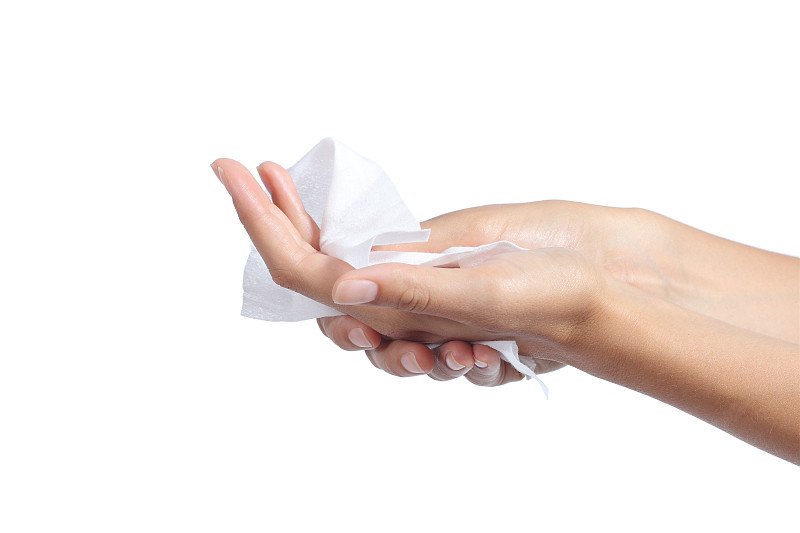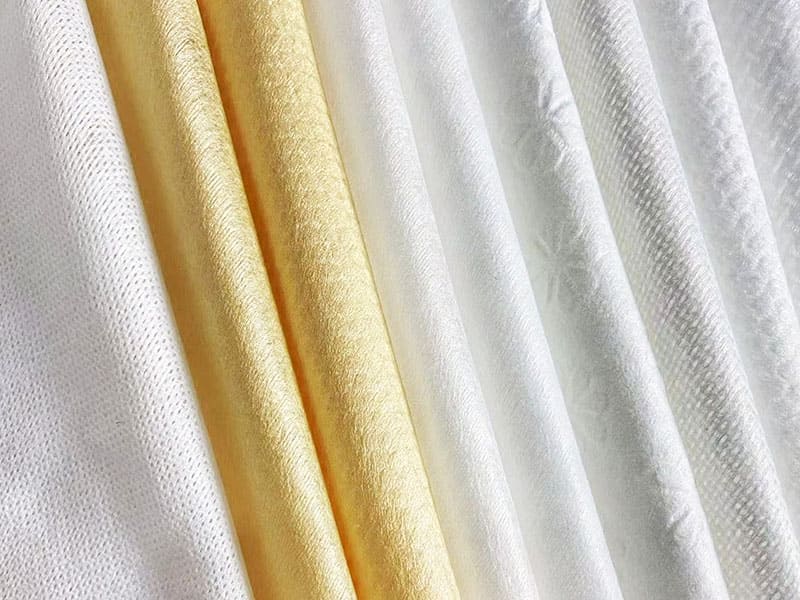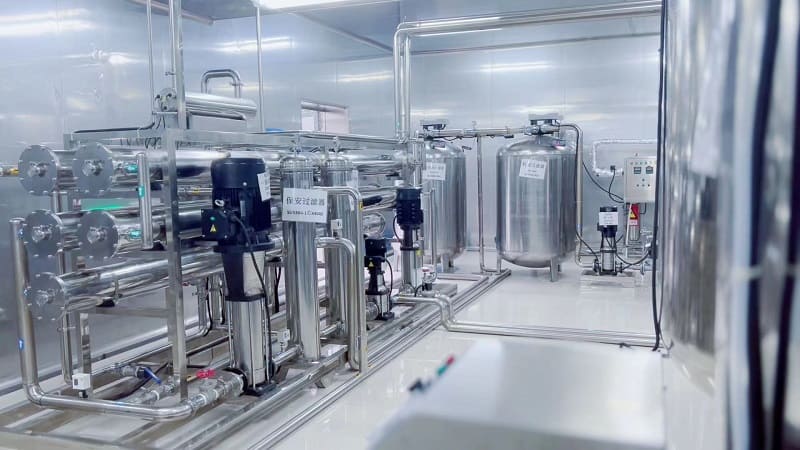Propre et frais en un seul passage - Lingettes humides, le guide d'hygiène ultime !
Les lingettes humides sont un produit polyvalent et pratique qui est devenu un incontournable dans les ménages et les entreprises. Ces lingettes jetables pré-humidifiées sont fabriquées dans un matériau non tissé doux, doux pour la peau et peuvent être utilisées à de nombreuses fins. Depuis hygiène personnelle à nettoyage et désinfection des surfaces, les lingettes humides ont des applications infinies dans la vie quotidienne.
Qu'il s'agisse d'essuyer le maquillage ou de se rafraîchir après une séance d'entraînement, les lingettes humides sont parfaites pour un nettoyage rapide en déplacement. Ils sont également couramment utilisés dans des industries telles que soins pour bébés, soins personnels, soins pour animaux de compagnie, nettoyage ménager, nettoyage industriel et hôtellerie maintenir des normes élevées d’hygiène et d’assainissement.
Grâce à leur commodité et leur polyvalence, les lingettes humides ont gagné leur place comme élément essentiel dans la vie de nombreuses personnes. Depuis petits paquets au format voyage à des bidons plus grands et baignoires pour un usage domestique, les lingettes humides sont disponibles en différentes tailles et types pour répondre à différents besoins. Alors pourquoi ne pas intégrer les lingettes humides à votre routine quotidienne et profiter par vous-même de leurs bienfaits ?

Quelques facteurs à prendre en compte si vous envisagez de créer une marque de lingettes humides
Non-tissé filé
Lors de l'élaboration d'un lingettes humides marque, choisir le bon tissu non tissé est essentiel. Le tissu non tissé Spunlace est un choix populaire en raison de sa douceur, de sa résistance et de son pouvoir absorbant. Il est doux pour la peau, suffisamment résistant pour résister à des essuyages répétés et très absorbant, ce qui en fait un choix efficace pour les lingettes humides. C'est aussi biodégradable et écologique, ce qui est de plus en plus important pour les consommateurs soucieux de l'environnement. Lors de la sélection d'un tissu non tissé, tenez compte non seulement de son douceur, résistance et capacité d'absorption, mais aussi son sécurité et impact environnemental. L’utilisation d’un tissu non tissé spunlace de haute qualité peut aider à créer des lingettes humides efficaces, sûres et respectueuses de l’environnement qui répondent aux besoins de votre public cible. En fin de compte, le bon tissu non tissé peut faire toute la différence dans la création d’une marque de lingettes humides à succès.
| PARAMÈTRES | NOTRE PROPOSITION |
|---|---|
| Fibre | Polyester/Viscose/Bambou Mélange personnalisé 20 % - 100 % Viscose |
| Grammage | 30-100 g/m² |
| Modèle | Maille, uni, en relief, gros point, petit point |


Le meilleur pour votre peau : de l'eau purifiée dans chaque lingette
Lors de la production de lingettes humides, QIMEI utilise de l'eau purifiée pour garantir que les lingettes sont exemptes d'impuretés susceptibles de provoquer une irritation cutanée ou d'autres problèmes. L'eau purifiée est de l'eau qui a subi un processus de filtration pour éliminer les impuretés telles que les produits chimiques, les minéraux et les micro-organismes.
L'utilisation d'eau purifiée est importante pour maintenir la qualité et la sécurité des lingettes humides, car l'eau du robinet peut contenir des produits chimiques ou des minéraux qui peuvent affecter l'efficacité des lingettes ou provoquer une irritation cutanée. De plus, l’utilisation d’eau purifiée contribue à prolonger la durée de conservation des lingettes en réduisant le risque de croissance bactérienne ou de contamination.
Chez QIMEI, nous utilisons le système d'eau ultrapure EDI pour garantir l'eau la plus pure pour chaque lingette.
La formule
En tant que fabricant de lingettes humides, Qimei a la capacité de développer des formulations personnalisées pour ses clients en fonction de leurs besoins. besoins et exigences spécifiques. Nous comprenons que différents clients peuvent avoir des préférences ou des exigences uniques concernant leurs lingettes humides, c'est pourquoi nous offrons la flexibilité nécessaire pour créer des formulations adaptées à leurs besoins.
Notre équipe de professionnels expérimentés possède l’expertise nécessaire pour développer des formulations efficaces et sûres qui respectent ou dépassent les normes de l’industrie. Nous sélectionnons soigneusement des ingrédients de haute qualité et effectuons des tests rigoureux pour garantir que nos formulations sont sûres, efficaces et répondent aux attentes de nos clients.
En plus de créer des formulations personnalisées pour nos clients, nous offrons également la possibilité de fabriquer des lingettes humides en utilisant les propres formulations de nos clients. Cela permet aux entreprises de garder le contrôle sur la formulation de leur produit et de s'assurer qu'il répond à leurs besoins et préférences spécifiques.



Matériel d'emballage de lingettes humides
Chez Qimei, nous comprenons que l'emballage des lingettes humides est tout aussi important que la qualité des lingettes elles-mêmes. C'est pourquoi nous proposons une gamme de matériaux d'emballage conçus pour garder les lingettes humides fraîches et protégées.
Nos matériaux d'emballage sont fabriqués à partir de matériaux sûrs, durables et respectueux de l'environnement et sont disponibles dans une variété de tailles et de styles pour répondre aux besoins uniques de nos clients. Nous proposons différents types de matériaux d'emballage parmi lesquels choisir, notamment :
-
Flow packs refermables: Les Flow Packs sont le choix le plus populaire pour les lingettes humides, fermeture avec autocollant/couvercle en plastique (couvercle/capuchon), car ils permettent un accès facile et aident à garder les lingettes fraîches et humides. Nous proposons différentes tailles et formes de flow packs refermables pour répondre à différents besoins.
-
Bidons: Les bidons sont une autre option d'emballage populaire, car ils offrent un moyen pratique et hygiénique de stocker et de distribuer des lingettes humides. Nos bidons sont fabriqués à partir de matériaux de haute qualité résistants à l'humidité et à d'autres facteurs environnementaux.
- Boîte: L'emballage en boîte fournit un contenant plus substantiel et plus stable pour les lingettes, ce qui le rend idéal pour une utilisation à la maison, au bureau ou dans d'autres environnements où plusieurs lingettes peuvent être nécessaires. La boîte peut également être facilement rechargée, réduisant ainsi les déchets et offrant une solution rentable.
- Emballage du seau: est un format plus grand pouvant contenir plus de lingettes, ce qui le rend adapté aux zones à fort trafic ou aux situations où un nettoyage fréquent est nécessaire. Le joint hermétique du seau aide à garder les lingettes humides et empêche la contamination, ce qui en fait une option idéale pour un usage industriel ou commercial.
-
Sachets: Pour une utilisation en déplacement, les sachets sont une option pratique qui peut facilement se glisser dans un sac à main ou une poche. Nos sachets sont fabriqués à partir de matériaux légers, faciles à ouvrir et à jeter.
Tous nos matériaux d'emballage sont personnalisables pour répondre aux besoins spécifiques de nos clients, notamment marque, film d'emballage laminé, étiquetage, couvercle/capuchon en plastique et autres options de personnalisation. Nous travaillons en étroite collaboration avec nos clients pour garantir que leur emballage est non seulement fonctionnel, mais également conforme à leur marque et à leurs objectifs marketing.
Foire aux questions - Matière première des lingettes humides
Quel type de non-tissé spunlace convient le mieux aux lingettes humides ?
De quoi sont faites les lingettes jetables ?
Combien de temps mettent les lingettes à se décomposer ?
Quel est l’ingrédient principal des lingettes humides ?
Quel conservateur contient les lingettes humides ?
De quoi sont faites les lingettes biodégradables ?
Quel type de non-tissé spunlace convient le mieux aux lingettes humides ?
Lorsqu'il s'agit de choisir le meilleur tissu non tissé spunlace pour lingettes humides, plusieurs options sont disponibles, chacune ayant des qualités uniques. Le type de non-tissé spunlace que vous choisirez dépendra des besoins spécifiques de votre produit et de son utilisation prévue.
Par exemple, si vous créez une lingette pour bébé, un tissu non tissé filé à base de coton serait un excellent choix. Ce type de tissu est super doux, très absorbant et doux pour la peau délicate.
D'un autre côté, si vous créez une lingette nettoyante, vous pouvez opter pour un non-tissé filé fabriqué à partir d'un mélange de polyester et de pâte de bois. Ce type de tissu est solide, durable et parfait pour lutter contre les dégâts tenaces.
Si vous fabriquez une lingette pour le visage ou un produit de beauté, un mélange de viscose et de polyester serait un excellent choix. Ce type de tissu a un toucher luxueux et soyeux qui est doux pour la peau.
Et si vous cherchez à créer une lingette humide écologique, un non-tissé filé à base de fibres de bambou serait un excellent choix. Non seulement il est biodégradable, mais il est également doux, résistant et absorbant.
En fin de compte, la clé pour choisir le meilleur non-tissé spunlace pour vos lingettes humides est de prendre en compte les besoins spécifiques de votre produit et de sélectionner un tissu qui fournira les résultats souhaités.
De quoi sont faites les lingettes jetables ?
Les lingettes jetables sont constituées d'une combinaison de matériaux, qui comprennent généralement un mélange de fibres de cellulose, de fibres synthétiques et d'agents liants. La composition exacte peut varier en fonction du fabricant et de l'utilisation prévue des lingettes.
La couche externe des lingettes jetables est généralement constituée d'un tissu non tissé filé, un matériau solide et durable qui peut résister à l'exposition à l'eau sans se décomposer.
La couche interne des lingettes jetables contient la solution de nettoyage, qui est généralement une combinaison d'eau, de détergents, de conservateurs et d'autres ingrédients formulés pour être doux pour la peau.
De plus, de nombreuses lingettes jetables sont traitées avec des additifs spéciaux qui aident à les décomposer lorsqu'elles sont rincées, ce qui les rend plus respectueuses de l'environnement.
It's important to note that not all wipes marketed as "flushable" are actually safe to flush. In some cases, these wipes can cause blockages in plumbing systems and contribute to environmental pollution. As such, it's important to follow the manufacturer's instructions carefully and only flush wipes that are specifically labeled as safe to flush.
Combien de temps mettent les lingettes à se décomposer ?
Le temps nécessaire à la décomposition des lingettes peut varier en fonction d'un certain nombre de facteurs, notamment du type de lingette, des matériaux à partir desquels elle est fabriquée et des conditions dans lesquelles elle est éliminée.
En général, la plupart des lingettes traditionnelles, y compris celles fabriquées à partir de fibres plastiques ou de coton, peuvent mettre plusieurs années, voire plusieurs décennies, à se décomposer dans une décharge. En effet, ils ne sont pas biodégradables et ne se décomposent pas facilement en présence d'oxygène, de soleil ou d'autres éléments naturels.
Les lingettes jetables, quant à elles, sont conçues pour se décomposer plus rapidement et plus facilement lorsqu’elles sont jetées dans l’eau. Cependant, même les lingettes jetables peuvent mettre un certain temps à se décomposer complètement et peuvent contribuer au blocage des réseaux d’égouts et des usines de traitement des eaux.
Pour minimiser l'impact environnemental des lingettes, il est important de les jeter correctement, en suivant les instructions figurant sur l'emballage. En général, il est préférable d’éviter de jeter tout type de lingettes dans les toilettes et de les jeter à la poubelle.
Quel est l’ingrédient principal des lingettes humides ?
L'ingrédient principal des lingettes humides est la solution d'essuyage, qui est généralement une combinaison d'eau, d'agents de nettoyage, de conservateurs et d'autres additifs. La composition exacte de la solution d'essuyage peut varier en fonction de l'utilisation prévue des lingettes.
L'eau est généralement l'ingrédient principal de la solution d'essuyage, servant de support aux autres ingrédients et fournissant de l'humidité pour aider à nettoyer et rafraîchir la peau. Les agents nettoyants, tels que les détergents et les tensioactifs, aident à éliminer la saleté, l'huile et autres impuretés de la peau.
Des conservateurs, tels que le chlorure de benzalkonium ou le phénoxyéthanol, sont ajoutés aux lingettes humides pour empêcher la croissance de bactéries et de moisissures, ce qui peut entraîner la détérioration ou la contamination des lingettes au fil du temps.
D'autres ingrédients, tels que des parfums, des hydratants et des agents revitalisants pour la peau, peuvent également être ajoutés aux lingettes humides pour améliorer leurs propriétés nettoyantes et rafraîchissantes et améliorer l'expérience de l'utilisateur.
Il est important de noter que certaines personnes peuvent être sensibles à certains ingrédients contenus dans les lingettes humides, tels que les parfums ou les conservateurs, et peuvent en conséquence ressentir une irritation cutanée ou des réactions allergiques. Si vous ressentez des effets indésirables lors de l'utilisation de lingettes humides, il est préférable d'arrêter de les utiliser et de consulter un professionnel de la santé.
Quel conservateur contient les lingettes humides ?
Il existe plusieurs conservateurs différents qui peuvent être utilisés dans les lingettes humides pour empêcher la croissance de bactéries, de champignons et d'autres micro-organismes susceptibles de provoquer une détérioration ou une contamination au fil du temps. Certains conservateurs courants trouvés dans les lingettes humides comprennent :
-
Chlorure de benzalkonium : Il s’agit d’un composé d’ammonium quaternaire efficace contre un large éventail de micro-organismes. Il est couramment utilisé dans les lingettes désinfectantes et autres produits de nettoyage.
-
Phénoxyéthanol : Il s'agit d'un éther de glycol efficace contre les bactéries et les champignons. Il est couramment utilisé dans les produits de soins personnels tels que les lingettes humides, les shampoings et les lotions.
-
Méthylisothiazolinone (MIT) : Il s'agit d'un composé synthétique efficace contre les bactéries et les champignons. Il est couramment utilisé dans les produits de soins personnels et les produits d’entretien ménager.
-
Chlorhexidine : Il s’agit d’un agent désinfectant et antiseptique efficace contre un large éventail de micro-organismes. Il est couramment utilisé dans les établissements de soins de santé et dans les produits de soins personnels tels que les lingettes humides.
Le choix du conservateur utilisé dans les lingettes humides peut dépendre de divers facteurs, notamment de l'utilisation prévue des lingettes, du pH de la solution d'essuyage et de la durée de conservation souhaitée du produit. Il est important de noter que certaines personnes peuvent être sensibles à certains conservateurs et peuvent en conséquence ressentir une irritation cutanée ou des réactions allergiques.
De quoi sont faites les lingettes biodégradables ?
Les lingettes biodégradables sont constituées de matériaux capables de se décomposer naturellement dans l'environnement, généralement par action microbienne ou enzymatique. Les matériaux spécifiques utilisés dans les lingettes biodégradables peuvent varier en fonction de la marque et de l'utilisation prévue des lingettes, mais certains matériaux courants incluent :
-
Cellulose : Il s'agit d'un polymère naturel dérivé de plantes et couramment utilisé dans les lingettes biodégradables comme alternative durable aux matériaux synthétiques.
-
Bambou : Il s’agit d’un autre matériau naturel couramment utilisé dans les lingettes biodégradables en raison de sa durabilité et de sa biodégradabilité.
-
Coton : Il s'agit d'une fibre naturelle souvent utilisée dans les lingettes biodégradables en raison de sa douceur et de son pouvoir absorbant.
-
Rayonne : Il s'agit d'une fibre synthétique dérivée de matières végétales et parfois utilisée dans les lingettes biodégradables comme alternative plus écologique aux autres matériaux synthétiques.
En plus des matériaux utilisés dans les lingettes elles-mêmes, les lingettes biodégradables peuvent également utiliser des ingrédients respectueux de l'environnement dans leurs solutions de nettoyage, tels que des tensioactifs d'origine végétale et des parfums naturels. L'objectif des lingettes biodégradables est de fournir une alternative plus durable et plus respectueuse de l'environnement aux lingettes traditionnelles, tout en offrant des propriétés nettoyantes et rafraîchissantes efficaces.
